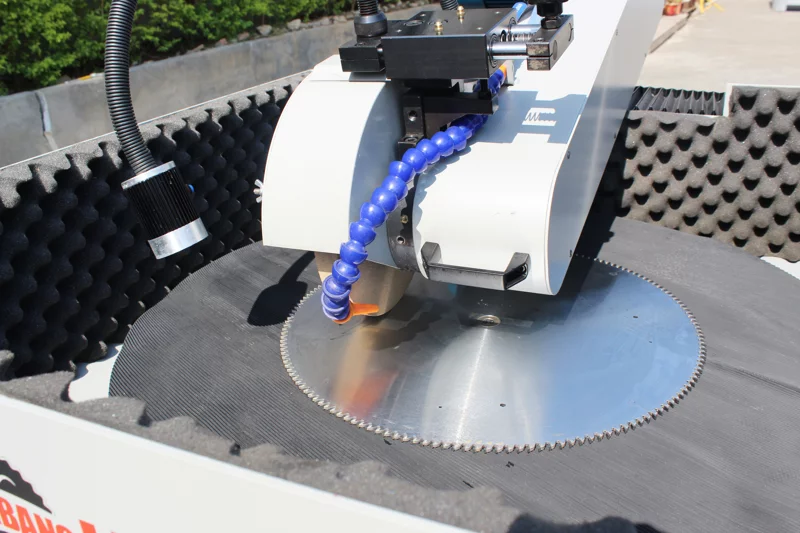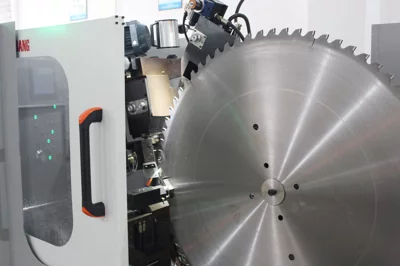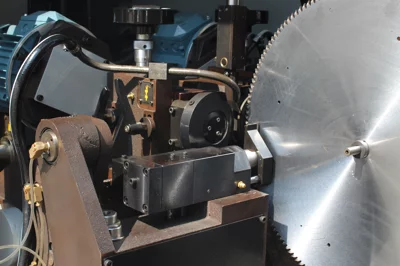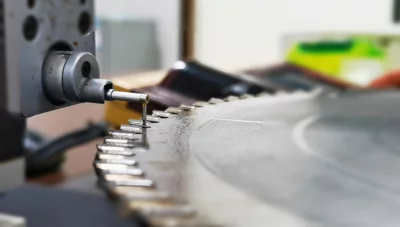Editing
Hard alloy saw blades are the most commonly used cutting tools in wood processing, and the quality of hard alloy saw blades is closely related to the quality of processed products. The correct and reasonable selection of hard alloy saw blades is of great significance for improving product quality, shortening processing cycles, and reducing processing costs.
Selection
Editing
Hard alloy saw blades include multiple parameters such as the type of alloy blade, material of the matrix, diameter, number of teeth, thickness, tooth shape, angle, aperture, etc. These parameters determine the processing ability and cutting performance of the saw blade. When selecting a saw blade, it is necessary to choose the right saw blade according to the type of cutting material, thickness, cutting speed, cutting direction, feed speed, and sawing path width.
Selection of Types
The commonly used types of hard alloy include tungsten-cobalt (code YG) and tungsten-titanium (code YT). Tungsten-cobalt hard alloys have better impact resistance, making them more widely used in the wood processing industry. Commonly used models in wood processing are YG8-YG15, with the number following YG indicating the percentage of cobalt content. As the cobalt content increases, the impact toughness and bending strength of the alloy improve, but the hardness and wear resistance decrease, so the selection should be based on the actual situation.
Selection of Matrix
1. 65Mn spring steel has good elasticity and plasticity, economical material, good through-hardening, low heat treatment temperature, and can be used for saw blades with low cutting requirements.
2. Carbon tool steel has high carbon content, high thermal conductivity, but its hardness and wear resistance sharply decrease when exposed to temperatures between 200-250°C, with tendencies for deformation during heat treatment, poor through-hardening, long tempering time, and susceptibility to cracking. It is a cost-effective material for tool manufacturing, such as T8A, T10A, T12A, etc.
Hard Alloy Saw Blades
Compared to alloy tool steel and carbon tool steel, hard alloy saw blades have good heat resistance, wear resistance, better processing performance, and are suitable for manufacturing high-grade alloy circular saw blades.
High-speed tool steel has good through-hardening, strong hardness and rigidity, minimal heat deformation, making it a super high-strength steel with stable thermoplastic properties, suitable for manufacturing high-grade ultra-thin saw blades.
Selection of Diameter
The diameter of the saw blade is related to the cutting equipment and the thickness of the workpiece. A smaller diameter results in relatively lower cutting speed, while a larger diameter requires higher demands for the saw blade and cutting equipment, but with higher cutting efficiency. The outer diameter of the saw blade should match the diameter specified for different circular saw machine models.
Standard diameters include: 110MM (4 inches), 150MM (6 inches), 180MM (7 inches), 200MM (8 inches), 230MM (9 inches), 250MM (10 inches), 300MM (12 inches), 350MM (14 inches), 400MM (16 inches), 450MM (18 inches), 500MM (20 inches), etc. Precision grooving saw blades are often designed with a bottom slot of 120MM.
Selection of Number of Teeth
The number of teeth on the saw blade determines the number of cutting edges within a unit time, resulting in better cutting performance with more teeth. However, the higher number of teeth requires more hard alloy material, leading to higher prices. Too many teeth can reduce the chip volume between teeth, causing overheating of the saw blade. Additionally, excessive teeth can result in minimal cutting per tooth, increasing friction between the cutting edge and the workpiece, affecting the blade's service life. Generally, the tooth spacing is between 15-25mm, and the appropriate number of teeth should be selected based on the material being cut.
Selection of Thickness
Ideally, thinner saw blades are preferred as thinner blades consume less material. The thickness of a saw blade is determined by the material of the alloy saw blade's matrix and the manufacturing process. If the blade is too thin, it may vibrate during work, affecting cutting efficiency. The selection of the blade thickness should consider the stability of the saw blade during work and the material being cut. Some special materials require specific thicknesses, which should be used according to equipment requirements, such as slotting saw blades, scoring saw blades, etc.
Selection of Tooth Shape
Common tooth shapes include left and right teeth (alternating teeth), flat teeth, ladder flat teeth (high-low teeth), reverse ladder teeth (reverse conical teeth), dovetail teeth (camelback teeth), and less common industrial-grade tooth shapes such as three left and one right, left-right-left-right flat teeth, etc.
Left-right teeth are the most widely used, offering fast cutting speed and easy sharpening. They are suitable for cutting various soft and hard solid wood profiles, density boards
Rake teeth are commonly used in the bottom slot saw blades of panel saws. When cutting double-faced man-made boards, the slot saw adjusts the thickness to complete the slot processing on the bottom surface, and then the main saw completes the cutting of the boards to prevent the occurrence of broken edges at the saw cut.
Examples of tooth shapes are as follows:
In summary, for cutting solid wood, plywood, and MDF, left-right teeth should be selected to cut wood fibers sharply and smoothly. For cutting veneer boards and fireproof boards, flat teeth or left-right flat combined teeth should be used to ensure a smooth slot bottom cut. Carbide-tipped circular saw blades are usually used for computerized cutting saws due to their large diameter and thickness. The diameter is around 350-450mm and the thickness is between 4.0-4.8mm, with most using flat teeth to reduce broken edges and saw marks.
Choice of tooth angle:
The choice of tooth angle is crucial for cutting quality. The main angle parameters are the front angle, back angle, and wedge angle. The front angle affects the cutting sharpness and ease of cutting. A larger front angle results in better cutting performance, especially for soft materials. The back angle and wedge angle also play important roles in the cutting process, affecting the friction and smoothness of the cut surfaces.
Selection of hole diameter:
The hole diameter is a relatively simple parameter, but it should be selected based on equipment requirements while maintaining blade stability. Larger diameter blades should have larger hole sizes for stability. Various hole sizes and shapes are available depending on the equipment used.
Identification and differentiation:
Hard alloy circular saw blades are composed of tungsten steel and are known for their cutting capabilities. When selecting a blade, one must consider the material being cut, the cutting direction, speed, and other factors to choose the appropriate blade. High-quality alloy teeth are essential for durability and cutting precision, and proper welding of the teeth is critical for performance.
How to identify:
Quality saw blades are characterized by thick tungsten carbide tips that can undergo multiple sharpening, ensuring a long lifespan. The welding quality of the tips is also important for withstanding cutting forces. The quality of the blade plate is crucial for stability and precision cutting. Dynamic stability is essential for maintaining cutting accuracy, especially when multiple blades are used together.
With years of hands-on experience, I have honed my skills in navigating the complexities of global commerce, offering invaluable insights and solutions to address customer needs. My commitment to excellence and dedication to customer satisfaction ensure that I deliver exceptional service, guiding clients through every step of the trading process with confidence and proficiency.





